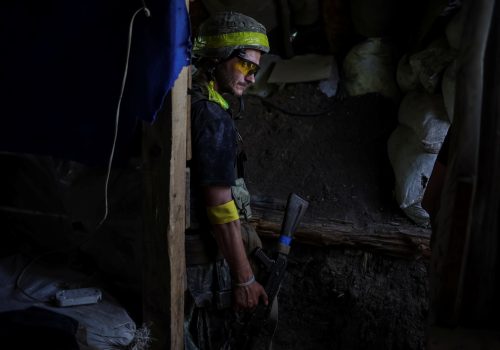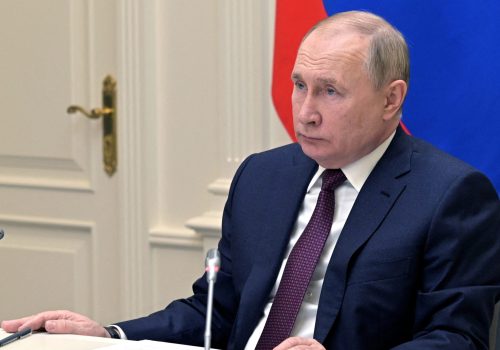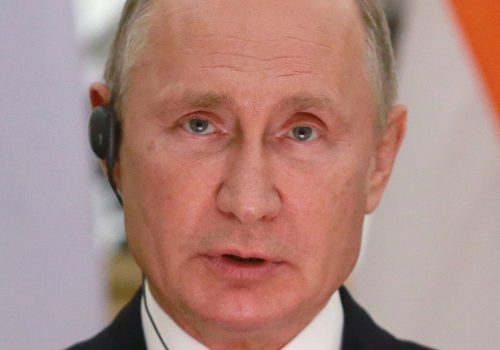
TO: POTUS
FROM: Matthew Kroenig
SUBJECT: How to deter Russian nuclear use in Ukraine—and respond if deterrence fails
What does the US president need to know? Our new “memo to the president” series has the answer with briefings on the world’s most pressing issues from our experts, drawing on their experience advising the highest levels of government.
Bottom line up front: Russia might use nuclear weapons to achieve its goals in the war in Ukraine—a risk that has only grown as Russian forces confront Ukrainian counteroffensives. Such nuclear use could advance the Kremlin’s military aims, undermine US interests globally, and set off a humanitarian catastrophe unseen since 1945. To deter such a potential disaster, the United States should issue public, deliberately vague threats of serious consequences for any Russian use of nuclear weapons and be prepared to follow through with conventional military strikes on Russian forces if deterrence fails.
Background: Russian nuclear use in Ukraine is possible and would be detrimental to US interests
Following Russia’s further invasion of Ukraine this year, the United States and its allies and partners have responded with military aid to Ukraine, sanctions on the Russian economy, and reinforcements to NATO’s eastern flank. To date, the United States and its allies have ruled out direct military intervention against Russia.
Nuclear threats are core to Russia’s military strategy, and there is a nonzero chance that Russian President Vladimir Putin will order a nuclear strike on Ukraine.
- Russia’s so-called “escalate-to-de-escalate” strategy calls for nuclear threats and, if necessary, limited nuclear use to compel the end to conflict on terms favorable to Moscow.
- Putin has made a series of nuclear threats against the United States and the West, with the aim of preventing them from coming to Ukraine’s defense.
- In addition, Russia has employed dual-capable weapons (which can carry both nuclear and conventional warheads) against Ukraine and conducted exercises with its nuclear forces.
- Putin may believe that he could use nuclear weapons to compel the United States and the West to cease their support for Ukraine.
- Russia has a wide range of options for conducting nonstrategic nuclear attacks by using one or more of the thousands of low-yield, battlefield nuclear weapons it already possesses. Russia could employ such nuclear weapons in a limited way against Ukrainian forces, bases, logistics hubs, and even cities.
Russian nuclear use would harm US interests in the war in Ukraine and globally.
- Such a strike could cause a humanitarian catastrophe, deal a crippling blow to the Ukrainian military, divide the Western alliance, and compel Kyiv to sue for peace.
- It would also break a nearly eight-decade taboo on nuclear use. It may make future nuclear use more likely if states (e.g., China) perceive that nuclear weapons can help them achieve their goals without resulting in serious military retaliation from the United States and its allies. Further, it could cause nuclear proliferation if states fear that nuclear weapons might be used against them or if US allies believe that Washington will not respond to a nuclear attack.
Recommendations for US policy to prevent Russian nuclear use
To prevent Russia from employing nuclear weapons in Ukraine, the United States should issue a clearer deterrent threat. It could choose between vague or explicit threats issued publicly or privately.
- At present, Putin may believe that he could use nuclear weapons without a significant Western response. A clearer US deterrent threat would help disabuse him of that notion.
- A vague threat (e.g., “Russia’s decision to use nuclear weapons in Ukraine would risk the gravest possible consequences”) has the benefit of conveying to Russia that there would be repercussions for nuclear use without committing the United States to a particular course of action.
- A more specific threat (e.g., “It shall be the policy of this nation to regard any nuclear attack against Ukraine as an attack on the United States, requiring a full retaliatory response”) would have greater deterrent value but limit US flexibility.
- While a vague threat could be dismissed as cheap talk, a more specific threat runs the risk of drawing a “red line” that Washington cannot enforce, making a vague threat the better option.
- These threats could be conveyed privately, but a public threat would likely be more effective in deterring Russia and assuring allies, as US credibility would be on the line for the world to see.
Recommendations for a US response to Russian nuclear use
A clearer threat should be sufficient to deter a Russian nuclear attack, but Washington must be prepared to execute its threat if deterrence fails.
Retaliatory option 1: The United States could intensify its current approach: increasing sanctions on Russia, further isolating Moscow internationally, arming Ukraine with more advanced weapons, and redoubling efforts to militarily reinforce Eastern Europe.
- Russian nuclear use might provide an opening to convince countries that have so far been reluctant—such as India and possibly even China—to participate in escalating sanctions.
- The United States could provide Ukraine with more advanced weapons to strike deeper into Russian territory and help Ukrainian units operate in a nuclear environment. This might include supplying iodine pills, radiation suits, Geiger counters, and other relevant material.
- The United States and NATO could strengthen their military posture in Eastern Europe, including adding heavier and permanent conventional forces while also relocating US nuclear weapons to Poland. They could announce the development of additional types of low-yield, theater nuclear weapons for deployment in Europe, such as a nuclear Joint Air-to-Surface Standoff Missile (JASSM) or Ground-Launched Cruise Missile (GLCM).
- The United States could go on nuclear alert to deter attacks on NATO allies. This could include taking visible steps to place warheads on bombers and sending nuclear submarines out to sea.
Pros: These steps would impose a cost on Russia, and Washington could plausibly claim that it has followed through on its deterrent threat.
Cons: There is a risk that many friends and foes will see these measures as an insufficient response to a nuclear attack.
Retaliatory option 2: The United States could respond with military force.
- Option 2A: The United States could conduct a limited conventional strike on the Russian forces or bases directly involved in the attack. A more robust version of this option would be to join the war on Ukraine’s side.
Pros: Direct US military intervention would be widely perceived as a meaningful response, potentially restoring nuclear deterrence in Ukraine and reinforcing the global nuclear taboo.
Cons: A military response increases the risk of escalation to a direct Russia-NATO war. Russia might conclude that the United States is unwilling to use nuclear weapons, encouraging additional Russian nuclear strikes. Some US allies might still see a conventional response to a nuclear attack as insufficient.
- Option 2B: The United States could use nuclear weapons to respond to and deter further Russian nuclear use in Ukraine.
Pros: A nuclear response is most likely to reinforce the deterrence of adversaries, result in the assurance of allies, and reestablish the global taboo against nuclear use in the future by demonstrating that countries cannot use nuclear weapons without dire consequences. Both allies and adversaries might be surprised or perceive weakness if the United States does not respond in kind to a nuclear attack on Ukraine.
Cons: A US decision to use nuclear weapons would raise challenging questions about what Russian target to hit with what US nuclear weapon. A US nuclear strike may restore deterrence, but it might also provoke a Russian nuclear reprisal, raising the risk of a larger nuclear exchange and further humanitarian disaster.
Given the costs and benefits above, the best US response if deterrence fails may be a mix of options 1 and 2A: an intensification of ongoing efforts to counter Russian aggression in Ukraine and a limited conventional strike against the Russian forces or bases that launched the nuclear attack.
Matthew Kroenig is the acting director of the Council’s Scowcroft Center for Strategy and Security. He previously served in the Department of Defense and the intelligence community in the Bush, Obama, and Trump administrations, including in the Strategy, Middle East, and Nuclear and Missile Defense offices in the Office of the Secretary of Defense and the Central Intelligence Agency’s Strategic Assessments Group.


